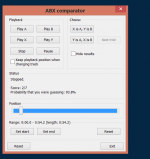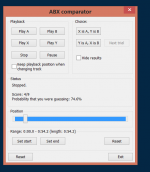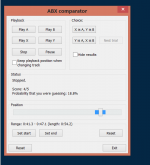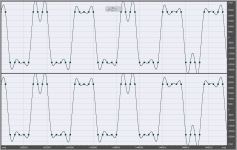Pavel, are you saying that you used Audacity to do the recording?
Oh no!
Thanks for clarification re dither.
One more remark. The ADC input range was 200 mVrms. (0dBFS = 200 mVrms). This makes it close to standard volume setup of the preamp, 200 mV would make about 4V at the ouput of the power amplifier.
Last edited:
Rerun with Foobar. On the third run I thought I would try and detect any difference in the piano envelope in the quieter parts. I would like to say that I was onto something but the concentration needed is huge and beyond this point the score fell away. But it was all as it happened.
Attachments
That might be very nice in theory, but the reality, on the ground, of what the full chain of playback/preamp/record is doing is somewhat different - it was very easy for me to find an obvious distortion between the source file and its copy:Comparison of distortion of the loaded and unloaded preamp. It is measured at higher amplitude than used in the test, otherwise everything would remain in noise even with narrow band FFT. Measured with notch filter, to see anything. Distortion components have changed from about -125dB (re fundamental) for unloaded to -120dB for loaded preamp. The output stage is biased at 40mA, it is very deeply in class A even if loaded.
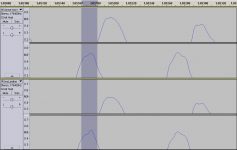
Rerun with Foobar. On the third run I thought I would try and detect any difference in the piano envelope in the quieter parts. I would like to say that I was onto something but the concentration needed is huge and beyond this point the score fell away. But it was all as it happened.
I unfortunately cannot share Pavel's enthousiasm about this score. The 'low probability that you are guessing' test only involves 5 tries. This makes it statistically more insignificant than the ones with a 'high probability that you are guessing', which consist of 9 tries.
Therefore, the outcome of the whole test - to me - is that you cannot discern an audible difference. Which is to be expected given the almost identical distortion profiles of both wav files.
The problem is that it is just very difficult psychologically to acknowledge a null result.
That might be very nice in theory, but the reality, on the ground, of what the full chain of playback/preamp/record is doing is somewhat different - it was very easy for me to find an obvious distortion between the source file and its copy:
View attachment 447290
And what is the source of distortion, Frank? Is it DAC, is it ADC, is it your sample rate conversion, it it a reconstruction filter used to display the samples, is it non-simultaneous sampling, time shift of the samples or anything else? At least the distortion measurement is quite accurate, same for time domain measurements. Everything else, like sampling errors and data manipulation is out of control.
I unfortunately cannot share Pavel's enthousiasm about this score.
My enthusiasm??
You are joking, right.
I tried the ABX as well - purely random result.
Last edited:
Somewhere in your copy chain, Pavel. Have a look at the size of the glitch - do you think software capable of 190dB and 1u sec resolution is going to inject that sort of anomaly? I've done much very high resolution work with Audacity, and in this sort of thing it's rock solid.And what is the source of distortion, Frank? Is it DAC, is it ADC, is it your sample rate conversion, it it a reconstruction filter used to display the samples, is it non-simultaneous sampling, time shift of the samples or anything else? At least the distortion measurement is quite accurate, same for time domain measurements. Everything else, like sampling errors and data manipulation is out of control.
I tried the ABX as well - purely random result.
That should tell you something. But you have to be willing to change your mind in the face of actual listening data.
BTW, you don't need 10/10 if you're happy with a 95% confidence level. 8/10 will get you there (and even a bit better- that's almost a 99% confidence).
That should tell you something. But you have to be willing to change your mind in the face of actual listening data.
What sort of changing my mind? Have I said that loaded output would be audible?
What sort of changing my mind? Have I said that loaded output would be audible?
Yes, some could hear the difference when opamps were loaded far above their specs.
Well, not you, not Mooly. And no-one else bothered to run an actual listening test.
I'm not following you here, Pavel ...You cannot compare non-simultaneous samples visually. Just check what you get from pure date and imagine small time shifts added.
Well, not you, not Mooly. And no-one else bothered to run an actual listening test.
Thank you. I was speaking about my test, the preamplifier loaded with 10 + 50 ohm, with measurements of this effect shown. I could not hear the difference when I tried to ABX Bolton x Blomley files. I hope I am clear enough now.
Somewhere in your copy chain, Pavel. Have a look at the size of the glitch - do you think software capable of 190dB and 1u sec resolution is going to inject that sort of anomaly? I've done much very high resolution work with Audacity, and in this sort of thing it's rock solid.
You are comparing the original data, 44.1kHz/16bit, with one of my recordings, performed at 48kHz/16 bit.
How was my recording done? 1st, 44.1kHz/16 bit was converted to 96kHz/24bit in foobar. Even this operation itself may change the envelope visually. The 96kHz/24 bit data were feeding the DAC (it works with smallest errors at 96/24) and two recordings, Bolton (unloaded) and Blomley (loaded) were done in 48kHz/16bits. Please do not compare Bolton/Blomley to Direct WAV, compare Bolton to Blomley only.
The editing software is doing exactly what a replay chain does when it is working perfectly - forming an analogue construct from the data points; joining the dots. At any specific time from the start of the waveform, a correct, analogue reconstruction of the audio signal will always look identical, irrespective of the sample rate or anything else - if it doesn't, then the signal has been distorted - on that image I posted the dots are so close together because of the level of oversampling that they are not shown, they perfectly fall on the path shown, they are all immediately adjacent. Look at the timeline, and the level of oversampling - they are continuous on the shown curve.
Interestingly, the distortion is worst at the beginning, it settles down and is far less obvious further along the clip - but has problems with DC offset, and gain.
Interestingly, the distortion is worst at the beginning, it settles down and is far less obvious further along the clip - but has problems with DC offset, and gain.
Thank you. I was speaking about my test, the preamplifier loaded with 10 + 50 ohm, with measurements of this effect shown. I could not hear the difference when I tried to ABX Bolton x Blomley files. I hope I am clear enough now.
Yes, thanks.
Interestingly, the distortion is worst at the beginning, it settles down and is far less obvious further along the clip - but has problems with DC offset, and gain.
Once again I would like to emphasize that Bolton x Blomley should be investigated. This is where the change (load added) was done. We are not exploring the SRC/DAC effect, we are exploring preamp under added load condition.
- Status
- Not open for further replies.
- Home
- Member Areas
- The Lounge
- John Curl's Blowtorch preamplifier part II
